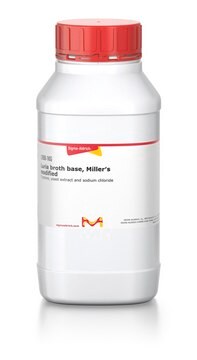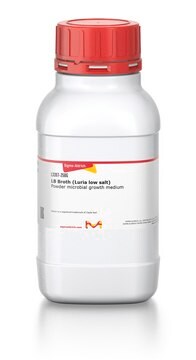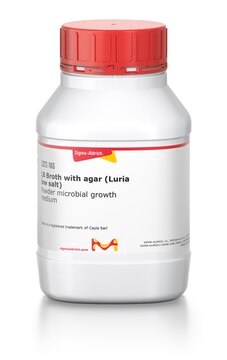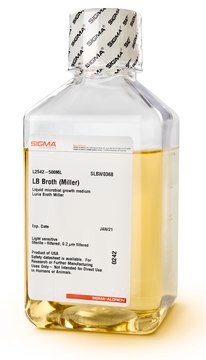L2025
Luria Agar Base, Miller
Tryptone, yeast extract, sodium chloride and agar
Sinonimo/i:
LA, modified, Luria-Bertani media, modified, Lysogeny broth, modified
Autenticatiper visualizzare i prezzi riservati alla tua organizzazione & contrattuali
About This Item
Codice UNSPSC:
41106200
eCl@ss:
42040102
NACRES:
NA.72
Prodotti consigliati
Stato
powder
tecniche
microbiological culture: suitable
applicazioni
agriculture
microbiology
Descrizione generale
Luria Bertani (LB) medium is one of the complex media that is widely used to grow Escherichia coli in small-scale cultures.
Applicazioni
Luria Agar Base, Miller has been used as a growth medium during plasmid amplification. It has also been used as a culture medium for strains of Penicillium sp. laika.
Luria broth/agar (LA), Miller (L1900) is a bacteria growth mixture of sodium chloride (0.5g/L); tryptone (10g/L) yeast extract (5g/L) and agar (15g/L) used to culture members of the Enterobacteriaceae family and for coliphage plaque assays.
Componenti
Contains: Tryptone, yeast extract, sodium chloride and agar.
Ricostituzione
Recommended use at 30.5 g per liter.
Codice della classe di stoccaggio
11 - Combustible Solids
Classe di pericolosità dell'acqua (WGK)
WGK 3
Punto d’infiammabilità (°F)
Not applicable
Punto d’infiammabilità (°C)
Not applicable
Scegli una delle versioni più recenti:
Possiedi già questo prodotto?
I documenti relativi ai prodotti acquistati recentemente sono disponibili nell’Archivio dei documenti.
I clienti hanno visto anche
Xiaoyun Qiu et al.
Applied and environmental microbiology, 70(11), 6435-6443 (2004-11-06)
We systematically investigated the physiological response as well as DNA damage repair and damage tolerance in Shewanella oneidensis MR-1 following UVC, UVB, UVA, and solar light exposure. MR-1 showed the highest UVC sensitivity among Shewanella strains examined, with D37 and
C Niu et al.
Applied and environmental microbiology, 70(12), 6951-6956 (2004-12-03)
The specific biofilm formation (SBF) assay, a technique based on crystal violet staining, was developed to locate plant essential oils and their components that affect biofilm formation. SBF analysis determined that cinnamon, cassia, and citronella oils differentially affected growth-normalized biofilm
Anthony S Danko et al.
Applied and environmental microbiology, 70(10), 6092-6097 (2004-10-07)
Pseudomonas putida strain AJ and Ochrobactrum strain TD were isolated from hazardous waste sites based on their ability to use vinyl chloride (VC) as the sole source of carbon and energy under aerobic conditions. Strains AJ and TD also use
Daria Julkowska et al.
Journal of bacteriology, 187(1), 65-76 (2004-12-17)
The natural wild-type Bacillus subtilis strain 3610 swarms rapidly on the synthetic B medium in symmetrical concentric waves of branched dendritic patterns. In a comparison of the behavior of the laboratory strain 168 (trp) on different media with that of
Yong-Guy Kim et al.
BMC microbiology, 11, 119-119 (2011-05-31)
Bacteria use diverse signaling molecules to ensure the survival of the species in environmental niches. A variety of both gram-positive and gram-negative bacteria produce large quantities of indole that functions as an intercellular signal controlling diverse aspects of bacterial physiology.
Il team dei nostri ricercatori vanta grande esperienza in tutte le aree della ricerca quali Life Science, scienza dei materiali, sintesi chimica, cromatografia, discipline analitiche, ecc..
Contatta l'Assistenza Tecnica.












